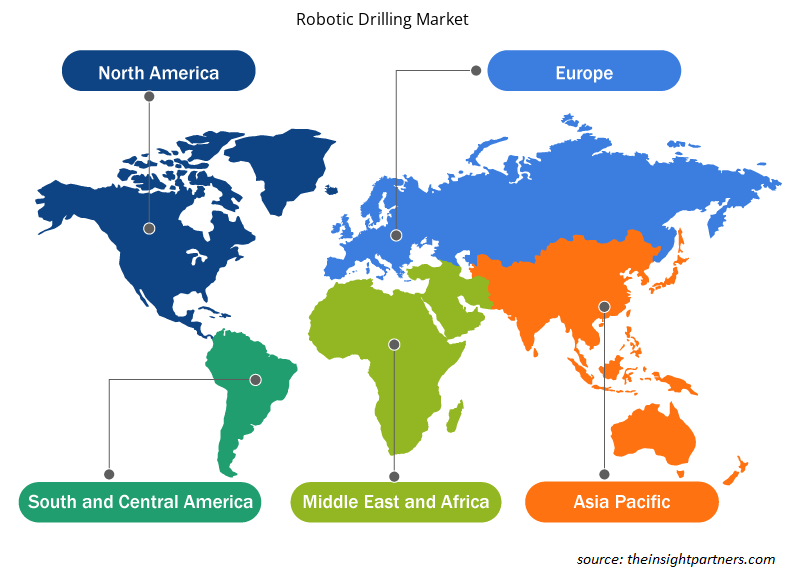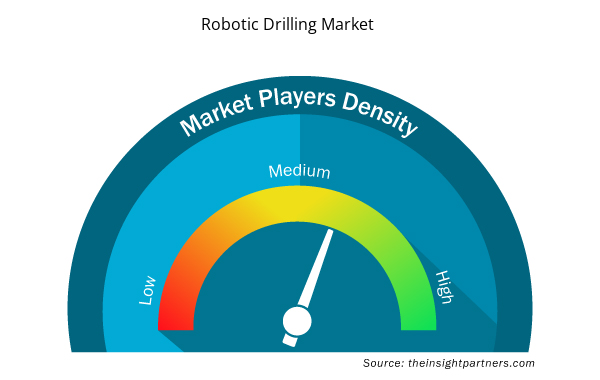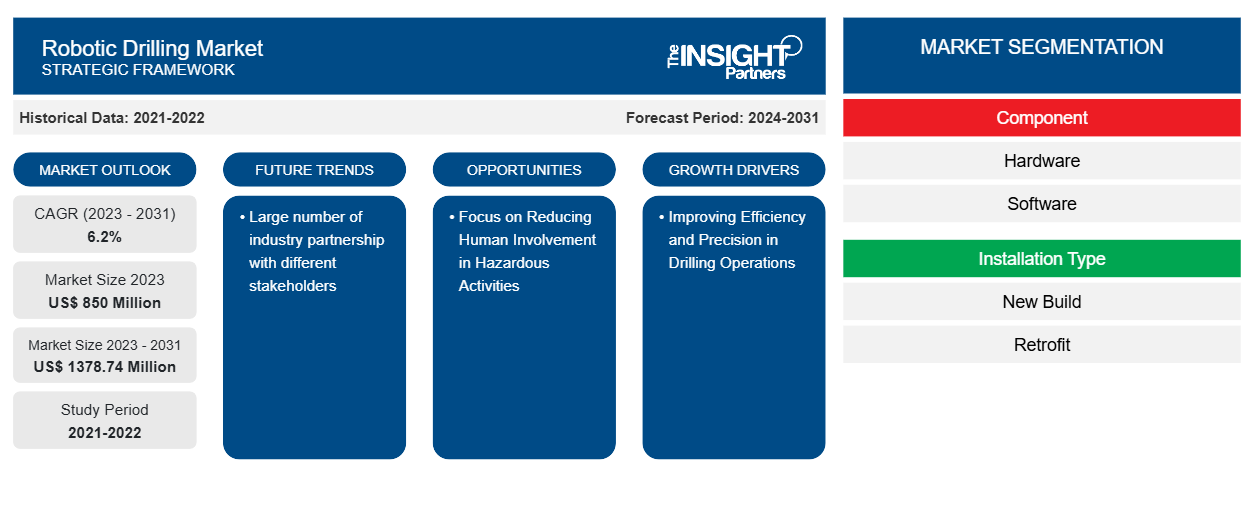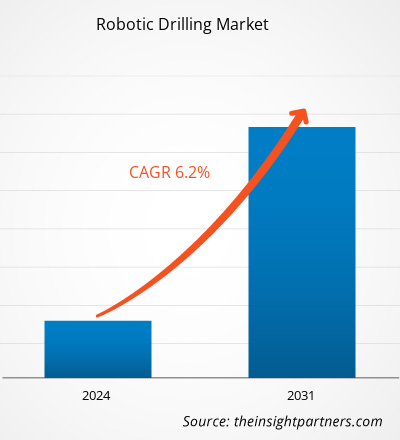ロボット掘削市場規模は、2023年の8億5,000万米ドルから2031年には13億7,874万米ドルに達すると予測されています。市場は 2023年から2031年にかけて6.2%のCAGRを記録すると予想されています。掘削活動の増加は、優れた炭化水素資源の開発と石油・ガス掘削における自動化とロボットの導入により、主に市場拡大を牽引しています。これにより、効率が向上し、掘削リグの安全性が向上します。
ロボット掘削市場分析
探査活動の増加、およびリスクがなく、費用対効果が高く、時間効率の良い方法で新しい石油・ガス田を開発することへの重点により、ロボット掘削システムの市場が拡大すると予測されています。しかし、近年の石油価格の変動、サイバーセキュリティの懸念、および初期コストの高さにより、ロボット掘削業界の成長は抑制されています。
ロボット掘削市場の概要
ロボット掘削は、自律掘削作業の主要技術です。掘削ロボットの制御により、安全で効率的な作業が保証され、人的ミスが削減されます。人口と都市が増加するにつれて、世界の化石燃料への依存は、石油とガスの需要の急速な増加につながっています。これにより、掘削活動が急増しています。石油とガスの探査におけるロボット掘削の使用は増加しており、産業化の進展と非在来型炭化水素埋蔵量の採掘により、業界は拡大する可能性があります。特に新興経済国での発電の拡大は、市場の成長を後押しすると予想されています。さらに、ロボット技術の発展は間接的な推進力として機能し、ロボット掘削市場の成長軌道を加速させます。
要件に合わせてレポートをカスタマイズする
このレポートの一部、国レベルの分析、Excelデータパックなど、あらゆるレポートを無料でカスタマイズできます。また、スタートアップや大学向けのお得なオファーや割引もご利用いただけます。
- このレポートの主要な市場動向を入手してください。この無料サンプルには、市場動向から見積もりや予測に至るまでのデータ分析が含まれます。
ロボット掘削市場の推進要因と機会
掘削作業の効率と精度を向上させて市場に有利に
石油・ガス、鉱業、生産など、幅広い業界における掘削作業の効率と精度の継続的な追求。ロボット掘削システムは精度を向上させ、人的ミスを減らし、標準的な生産性を高めます。掘削作業で最も重要な要素は安全性です。ロボット構造により、特に沖合や困難な地形での危険な環境への人間の露出が減ります。
危険な活動への人間の関与を減らすことに重点を置く
危険な掘削シナリオへの人間の露出を制限するために、企業はロボット掘削セクターにおける安全性とリスク軽減を優先しています。従来の掘削作業、典型的には石油・ガス探査、採鉱、建設などの業界では、肉体的に過酷でリスクの高い作業を実行するために人間の労働者に依存しています。ロボット掘削技術により、掘削作業はより安全でセキュリティが強化され、ビジネス環境が一変しました。ロボット掘削により、危険な掘削活動に人間が参加する必要性が低下します。これらの作業は、危険な鉱山、沖合の石油掘削装置、深海プラットフォームなど、困難な場所や遠隔地で行われることがよくあります。
このような状況にある従業員は、事故、有毒物質への曝露、異常気象など、さまざまなリスクに直面します。企業はロボット掘削装置を使用してリスクを軽減し、従業員の安全性を向上させることができます。
ロボット掘削市場レポートのセグメンテーション分析
ロボット掘削市場分析の導出に貢献した主要なセグメントは、コンポーネント、設置タイプ、およびアプリケーションです。
- コンポーネントに基づいて、ロボット掘削市場はハードウェアとソフトウェアに分けられます。
- 設置タイプ別に見ると、市場は新築と改修に分かれています。
- に関してはアプリケーションによって、市場はオンショアとオフショアに分割されます。
ロボット掘削市場シェアの地域別分析
ロボット掘削市場レポートの地理的範囲は、主に北米、アジア太平洋、ヨーロッパ、中東およびアフリカ、南米/中南米の 5 つの地域に分かれています。北米での最近のシェールガス開発により、ロボット掘削装置の市場は劇的に成長しました。メキシコ湾での探査も増加しており、地域のロボット掘削システム市場を牽引しています。掘削コストの上昇と石油価格の低下により、米国のオフショア掘削装置数と石油生産量が大幅に増加し、オフショア掘削の拡大が示唆されており、これが米国のロボット掘削市場の主要な推進力になると予測されています。
ロボット掘削市場の地域別洞察
予測期間を通じてロボット掘削市場に影響を与える地域的な傾向と要因は、Insight Partners のアナリストによって徹底的に説明されています。このセクションでは、北米、ヨーロッパ、アジア太平洋、中東、アフリカ、南米、中米にわたるロボット掘削市場のセグメントと地理についても説明します。

- ロボット掘削市場の地域別データを入手
ロボット掘削市場レポートの範囲
| レポート属性 | 詳細 |
|---|---|
| 2023年の市場規模 | 8億5000万米ドル |
| 2031年までの市場規模 | 13億7,874万米ドル |
| 世界のCAGR(2023年~2031年) | 6.2% |
| 履歴データ | 2021-2022 |
| 予測期間 | 2024-2031 |
| 対象セグメント | コンポーネント別
|
| 対象地域と国 | 北米
|
| 市場リーダーと主要企業プロフィール |
|
ロボット掘削市場のプレーヤー密度:ビジネスダイナミクスへの影響を理解する
ロボット掘削市場は、消費者の嗜好の変化、技術の進歩、製品の利点に対する認識の高まりなどの要因により、エンドユーザーの需要が高まり、急速に成長しています。需要が高まるにつれて、企業は提供を拡大し、消費者のニーズを満たすために革新し、新たなトレンドを活用し、市場の成長をさらに促進しています。
市場プレーヤー密度とは、特定の市場または業界内で活動している企業または会社の分布を指します。これは、特定の市場スペースに、その規模または総市場価値と比較して、どれだけの競合相手 (市場プレーヤー) が存在するかを示します。
ロボット掘削市場で事業を展開している主要企業は次のとおりです。
- ベーカー・ヒューズ
- シュルンベルジェ
- ハリバートン
- キャタピラー
- ナショナルオイルウェル・ヴァルコ
- アトラスコプコ
免責事項:上記の企業は、特定の順序でランク付けされていません。

- ロボット掘削市場のトップキープレーヤーの概要を入手
ロボット掘削市場のニュースと最近の動向
ロボット掘削市場は、主要な企業出版物、協会データ、データベースを含む一次調査と二次調査後の定性的および定量的データを収集することによって評価されます。以下は、市場の動向の一覧です。
- 2021年3月、シュルンベルジェは、イラク、日本、インドネシア、中国のパートナーとともに大規模なウェストクルナ1油田を運営するバスラ石油会社とエクソンモービルのために、イラク南部で96本の油井を掘削する4億8,000万ドルの契約を獲得した。
(出典:シュルンベルジェ、企業ウェブサイト、2021年)
- 2021年10月、Nabors Industries Ltdは、Canrigロボットを搭載した完全自動陸上掘削リグPACE-R801を発表しました。パーミアン盆地での最初の井戸で完全な深度を達成しました。レッドゾーンの場所から作業員を排除し、安定した掘削パフォーマンスを提供するために、自律型リグフロアを設計しました。
(出典:Nabors Industries Ltd、企業ウェブサイト、2021年)
ロボット掘削市場レポートの対象範囲と成果物
「ロボット掘削市場の規模と予測(2021〜2031年)」レポートでは、以下の分野をカバーする市場の詳細な分析を提供しています。
- 対象範囲に含まれるすべての主要市場セグメントの世界、地域、国レベルでの市場規模と予測
- 市場の動向(推進要因、制約、主要な機会など)
- 今後の主な動向
- 詳細なPEST/ポーターの5つの力とSWOT分析
- 主要な市場動向、主要プレーヤー、規制、最近の市場動向を網羅した世界および地域の市場分析
- 市場集中、ヒートマップ分析、主要プレーヤー、最近の動向を網羅した業界の状況と競争分析
- 詳細な企業プロフィール
- 過去2年間の分析、基準年、CAGRによる予測(7年間)
- PEST分析とSWOT分析
- 市場規模価値/数量 - 世界、地域、国
- 業界と競争環境
- Excel データセット


- Rare Neurological Disease Treatment Market
- Aerosol Paints Market
- Occupational Health Market
- Wire Harness Market
- Green Hydrogen Market
- Space Situational Awareness (SSA) Market
- Single-Use Negative Pressure Wound Therapy Devices Market
- Machine Condition Monitoring Market
- Pharmacovigilance and Drug Safety Software Market
- Compounding Pharmacies Market

Report Coverage
Revenue forecast, Company Analysis, Industry landscape, Growth factors, and Trends

Segment Covered
This text is related
to segments covered.

Regional Scope
North America, Europe, Asia Pacific, Middle East & Africa, South & Central America

Country Scope
This text is related
to country scope.
よくある質問
The global robotic drilling market is expected to reach US$ 1378.74 million by 2031.
The key players holding the majority of shares in the global robotic drilling market are Baker Hughes, Schlumberger, Halliburton, Caterpillar, and National Oilwell Varco.
A large number of industry partnerships with different stakeholders to play a significant role in the global robotic drilling market in the coming years.
Improving efficiency and precision in drilling operations are the major factors that propel the global robotic drilling market.
The global robotic drilling market was estimated to be US$ 850 million in 2023 and is expected to grow at a CAGR of 6.2% during the forecast period 2023 - 2031.
Trends and growth analysis reports related to Electronics and Semiconductor : READ MORE..
The Insight Partners performs research in 4 major stages: Data Collection & Secondary Research, Primary Research, Data Analysis and Data Triangulation & Final Review.
- Data Collection and Secondary Research:
As a market research and consulting firm operating from a decade, we have published and advised several client across the globe. First step for any study will start with an assessment of currently available data and insights from existing reports. Further, historical and current market information is collected from Investor Presentations, Annual Reports, SEC Filings, etc., and other information related to company’s performance and market positioning are gathered from Paid Databases (Factiva, Hoovers, and Reuters) and various other publications available in public domain.
Several associations trade associates, technical forums, institutes, societies and organization are accessed to gain technical as well as market related insights through their publications such as research papers, blogs and press releases related to the studies are referred to get cues about the market. Further, white papers, journals, magazines, and other news articles published in last 3 years are scrutinized and analyzed to understand the current market trends.
- Primary Research:
The primarily interview analysis comprise of data obtained from industry participants interview and answers to survey questions gathered by in-house primary team.
For primary research, interviews are conducted with industry experts/CEOs/Marketing Managers/VPs/Subject Matter Experts from both demand and supply side to get a 360-degree view of the market. The primary team conducts several interviews based on the complexity of the markets to understand the various market trends and dynamics which makes research more credible and precise.
A typical research interview fulfils the following functions:
- Provides first-hand information on the market size, market trends, growth trends, competitive landscape, and outlook
- Validates and strengthens in-house secondary research findings
- Develops the analysis team’s expertise and market understanding
Primary research involves email interactions and telephone interviews for each market, category, segment, and sub-segment across geographies. The participants who typically take part in such a process include, but are not limited to:
- Industry participants: VPs, business development managers, market intelligence managers and national sales managers
- Outside experts: Valuation experts, research analysts and key opinion leaders specializing in the electronics and semiconductor industry.
Below is the breakup of our primary respondents by company, designation, and region:

Once we receive the confirmation from primary research sources or primary respondents, we finalize the base year market estimation and forecast the data as per the macroeconomic and microeconomic factors assessed during data collection.
- Data Analysis:
Once data is validated through both secondary as well as primary respondents, we finalize the market estimations by hypothesis formulation and factor analysis at regional and country level.
- Macro-Economic Factor Analysis:
We analyse macroeconomic indicators such the gross domestic product (GDP), increase in the demand for goods and services across industries, technological advancement, regional economic growth, governmental policies, the influence of COVID-19, PEST analysis, and other aspects. This analysis aids in setting benchmarks for various nations/regions and approximating market splits. Additionally, the general trend of the aforementioned components aid in determining the market's development possibilities.
- Country Level Data:
Various factors that are especially aligned to the country are taken into account to determine the market size for a certain area and country, including the presence of vendors, such as headquarters and offices, the country's GDP, demand patterns, and industry growth. To comprehend the market dynamics for the nation, a number of growth variables, inhibitors, application areas, and current market trends are researched. The aforementioned elements aid in determining the country's overall market's growth potential.
- Company Profile:
The “Table of Contents” is formulated by listing and analyzing more than 25 - 30 companies operating in the market ecosystem across geographies. However, we profile only 10 companies as a standard practice in our syndicate reports. These 10 companies comprise leading, emerging, and regional players. Nonetheless, our analysis is not restricted to the 10 listed companies, we also analyze other companies present in the market to develop a holistic view and understand the prevailing trends. The “Company Profiles” section in the report covers key facts, business description, products & services, financial information, SWOT analysis, and key developments. The financial information presented is extracted from the annual reports and official documents of the publicly listed companies. Upon collecting the information for the sections of respective companies, we verify them via various primary sources and then compile the data in respective company profiles. The company level information helps us in deriving the base number as well as in forecasting the market size.
- Developing Base Number:
Aggregation of sales statistics (2020-2022) and macro-economic factor, and other secondary and primary research insights are utilized to arrive at base number and related market shares for 2022. The data gaps are identified in this step and relevant market data is analyzed, collected from paid primary interviews or databases. On finalizing the base year market size, forecasts are developed on the basis of macro-economic, industry and market growth factors and company level analysis.
- Data Triangulation and Final Review:
The market findings and base year market size calculations are validated from supply as well as demand side. Demand side validations are based on macro-economic factor analysis and benchmarks for respective regions and countries. In case of supply side validations, revenues of major companies are estimated (in case not available) based on industry benchmark, approximate number of employees, product portfolio, and primary interviews revenues are gathered. Further revenue from target product/service segment is assessed to avoid overshooting of market statistics. In case of heavy deviations between supply and demand side values, all thes steps are repeated to achieve synchronization.
We follow an iterative model, wherein we share our research findings with Subject Matter Experts (SME’s) and Key Opinion Leaders (KOLs) until consensus view of the market is not formulated – this model negates any drastic deviation in the opinions of experts. Only validated and universally acceptable research findings are quoted in our reports.
We have important check points that we use to validate our research findings – which we call – data triangulation, where we validate the information, we generate from secondary sources with primary interviews and then we re-validate with our internal data bases and Subject matter experts. This comprehensive model enables us to deliver high quality, reliable data in shortest possible time.


 このレポートの無料サンプルを入手する
このレポートの無料サンプルを入手する